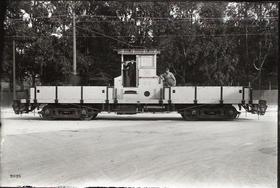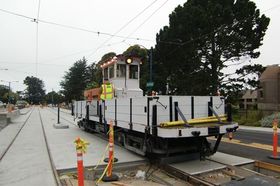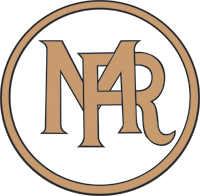In many cities, streetcars replaced horse cars to carry people. This streetcar did the work of horses in a different way. San Francisco Municipal Railway streetcar No. C-1 wasn’t built to carry passengers. Properly called a “motor flat”, it was built to carry almost everything else, though.
In the early 20th Century, streetcar tracks often ran on unpaved streets, and well away from the city centers to what was then the country. Streetcar operators needed a variety of work equipment to keep the tracks and overhead wires in shape and perform odd jobs. Most operators around the country converted obsolete passenger cars to do these often-dirty tasks. But Muni’s first work car was specially built to…well, work!
 It was most probably built by Pacific Car and Equipment Company of South San Francisco. The photo at left, taken on March 17, 1916, shows the car when new. It incorporates the same Westinghouse HL controllers and powerful Westinghouse 306CA motors used on Muni’s A-type passenger cars built in 1912 and 1913 (of which passenger Car No. 1 is preserved). Car No. C-1 was essentially a motorized railroad-style flat car with an operator’s cab in the middle and hinged sidewalls that dropped. It was painted the same gray with red trim as Muni’s passenger cars.
It was most probably built by Pacific Car and Equipment Company of South San Francisco. The photo at left, taken on March 17, 1916, shows the car when new. It incorporates the same Westinghouse HL controllers and powerful Westinghouse 306CA motors used on Muni’s A-type passenger cars built in 1912 and 1913 (of which passenger Car No. 1 is preserved). Car No. C-1 was essentially a motorized railroad-style flat car with an operator’s cab in the middle and hinged sidewalls that dropped. It was painted the same gray with red trim as Muni’s passenger cars.
Most of No. C-1’s work over the years consisted of hauling rails, ties, asphalt, sand, and ballast needed to maintain a streetcar system. At times, it carried weed spray gear to poison unwanted plants along streetcar rights-of-way. The late Ted Wurm remembered that the car was even used a few times to carry tree trimmings from Golden Gate Park to downtown merchants to use as holiday decorations.
As the years went by, work cars like No. C-1 gave way to service trucks for most jobs. After it acquired its private rival, Market Street Railway Co. (MSRy) in 1944, Muni scrapped its other work equipment, converted single-truck passenger cars, in favor of equivalents from MSRy. (On of these ex-MSRy cars, line car No. 0304, still belongs to Muni. Another was restored by Muni in 1956 to its 1895 appearance as Car No. 578.)
Car No. C-1 soldiered on for Muni, rarely used, until 1975. Then, space constraints led Muni to loan it to the Western Railway Museum in Solano County. However, in early 1992, Muni needed a test car with the same wheelbase as the new Breda LRVs on order. They wanted to ensure that the new cars, as designed, would clear all the tight spots on the system. So they recalled No. C-1 and fit it with a framework that matched the body dimensions of the Breda cars. Then, with contributions from Breda and help from Muni, Market Street Railway volunteers restored the car, by now considerably altered, to its original appearance, as a gift to Muni for its 80th birthday. New drop sides were fabricated to replace long-gone originals, stripping and varnishing the oak sash and door, and creation of a fresh gold-leaf “MR” logo, a handsome insignia that Muni surprisingly applied only to this car.
The motor flat’s return to active duty was officially celebrated on Muni’s 80th birthday, December 28, 1992, at MSR’s “Mint Division” restoration yard. More than 100 Muni officials, Market Street Railway members, and civic dignitaries attended the ceremony. Car No. C-1 received more attention than ever in its long life, including a San Francisco Chronicle story that described it as a “drudge made queen for a day”.
 Since that day, No. C-1 could be said to have “reigned” over the Muni system, as unlikely a monarch as could be. Carefully tended by MSR and Muni, it is nonetheless still a blue-collar car, now fitted with a generator that frees it from needing overhead wires. Its most frequent job in the last two decades has been testing new track and switches installed as part of the creation of new ones, such as the F-line and the T-line, or the reconstruction of existing lines, such as the K and M at St. Francis Circle in 2010, shown here.
Since that day, No. C-1 could be said to have “reigned” over the Muni system, as unlikely a monarch as could be. Carefully tended by MSR and Muni, it is nonetheless still a blue-collar car, now fitted with a generator that frees it from needing overhead wires. Its most frequent job in the last two decades has been testing new track and switches installed as part of the creation of new ones, such as the F-line and the T-line, or the reconstruction of existing lines, such as the K and M at St. Francis Circle in 2010, shown here.
Now in its second century of service, even though it doesn’t carry passengers, it still carries a place of honor in Muni’s historic streetcar fleet.
 Originally Built For
Originally Built ForSan Francisco Municipal Railway (Muni), San Francisco, California, 1916
Builder
Pacific Car and Equipment Co., South San Francisco, California
Weight
40,000 lbs.
Length
40′ 8″
Width
8′ 6″
Bin Capacity
20 cubic yards
Motors
4 Westinghouse 306CA
Control
Westinghouse HL
Trucks
Brill (34″ wheels)
